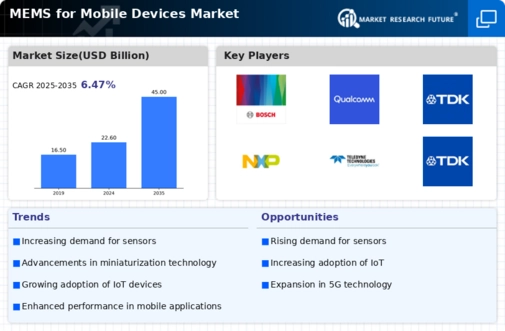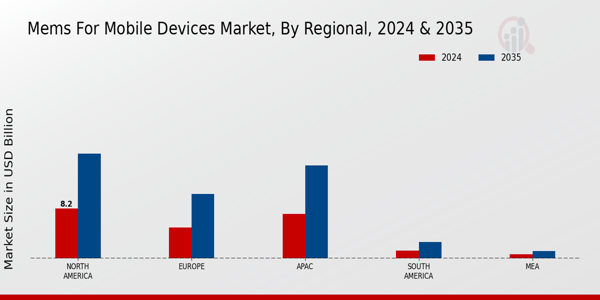Advancements in Smartphone Features
The continuous evolution of smartphone features serves as a substantial driver for the MEMS for Mobile Devices Market. As manufacturers strive to differentiate their products, the incorporation of advanced MEMS sensors becomes increasingly critical. Features such as enhanced camera stabilization, improved navigation, and augmented reality applications rely heavily on MEMS technology. Recent data indicates that the smartphone market is expected to grow at a compound annual growth rate of approximately 5% through 2027, which may lead to heightened demand for MEMS components. This trend suggests that as smartphones become more sophisticated, the MEMS for Mobile Devices Market will likely experience a corresponding increase in demand for innovative sensor solutions.
Increased Focus on Autonomous Systems
The heightened focus on autonomous systems, including drones and self-driving vehicles, is a notable driver for the MEMS for Mobile Devices Market. These systems require precise navigation and control, which are facilitated by MEMS sensors such as inertial measurement units (IMUs) and pressure sensors. As the automotive industry invests heavily in autonomous technology, the demand for MEMS components is expected to rise. Recent projections suggest that the autonomous vehicle market could reach a valuation of 60 billion dollars by 2030, indicating a robust growth trajectory. This trend suggests that the MEMS for Mobile Devices Market will likely see increased investment and innovation in sensor technologies to support the development of autonomous systems.
Rising Demand for Wearable Technology
The increasing popularity of wearable technology is a pivotal driver for the MEMS for Mobile Devices Market. As consumers seek devices that can monitor health metrics, fitness levels, and other personal data, the demand for MEMS sensors, such as accelerometers and gyroscopes, is likely to surge. According to recent estimates, the wearable technology market is projected to reach a valuation of over 60 billion dollars by 2026, which could significantly boost the MEMS sector. These sensors are essential for enabling functionalities in smartwatches, fitness trackers, and health monitoring devices, thereby enhancing user experience and engagement. The integration of MEMS technology into these devices not only improves performance but also contributes to the overall growth of the MEMS for Mobile Devices Market.
Growing Internet of Things (IoT) Applications
The proliferation of Internet of Things (IoT) applications is emerging as a significant driver for the MEMS for Mobile Devices Market. As more devices become interconnected, the need for MEMS sensors to facilitate communication and data collection is becoming increasingly apparent. MEMS technology plays a crucial role in enabling smart home devices, industrial automation, and smart city initiatives. The IoT market is projected to reach a valuation of over 1 trillion dollars by 2026, which could create substantial opportunities for MEMS manufacturers. This growth indicates that the MEMS for Mobile Devices Market is likely to benefit from the rising demand for sensors that can enhance connectivity and functionality across various applications.
Emerging Applications in Augmented and Virtual Reality
The emergence of augmented reality (AR) and virtual reality (VR) applications is driving innovation within the MEMS for Mobile Devices Market. As these technologies gain traction in gaming, education, and training, the demand for MEMS sensors that enhance user experience is likely to grow. MEMS accelerometers and gyroscopes are essential for motion tracking and spatial awareness in AR and VR devices. The AR and VR market is projected to exceed 200 billion dollars by 2025, which could significantly impact the MEMS sector. This growth indicates that the MEMS for Mobile Devices Market is poised to benefit from the increasing integration of MEMS technology in immersive applications, thereby enhancing the overall user experience.

















Leave a Comment